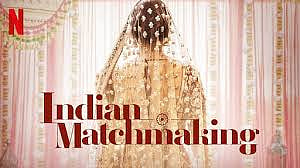The web series Indian Matchmaking (on Netflix), is currently generating much heated debate and dozens of mocking memes. Indians are cringing at the nasty portrayal of the traditional arranged marriage and westerners are amused.
The documentary series, directed by Smriti Mundhra, has as its narrator, Sima Taparia, a jet-setting matchmaker, whose meetings with clients are interspersed with her pronouncements about how women should be adjusting and compromising if they are looking for a husband, and her exasperation over two male clients who have rejected hundreds of girls.
It is surprising that a bunch of people agreed to let it all hang out for the series, and opened themselves up to ridicule and gross invasion of privacy. The biggest problem with the show is that it limits itself to upper class men and women, who live in palatial apartments and have successful careers. The ugliness of the arranged marriage is actually on full display in the middle class milieu, where negotiations over dowry and wedding expenses can wreck the girl’s family, and still offer no security or social stability to her, which is what the parents hope for. Dowry is one of the reasons why there is such a heavy bias against the girl child in India, which leads to female foeticide or infanticide. Mundhra had also co-directed with Sarita Khurana, a documentary called The Suitable Girl (2017) that laid bare the lives of three young women, with all the crushing power of tradition they have to deal with. This includes Sima Taparia’s own daughter, who wishes to pursue a career, but is forced to get married, because that’s what her parents want. Another young woman who gets married and moves to a small town has to dress and live the way her in-laws expect her to. In India, unfortunately, a woman’s identity is easily erased after marriage, particularly if she moves in with her in-laws. She is required to change her surname, and in some communities, even her first name is changed, to signify a break from her own family.
The attractive and accomplished women Sima (in three years she has upgraded herself) meets are jittery because they are nearing—or past—the marriageable age and have already tried the dating route. Having failed at finding love, they are willing to try a traditional matchmaker, with her file of “biodatas” that list details of appearance, career, hobbies and expectations from a partner. With the Indian community, even in the west, families are involved in the meeting with potential spouses, and parental approval is sought—more so in an arranged marriage.
Of course, there is rejection from either side, though it seems to affect the women much more. Except for people with great confidence or high self-esteem, this process of trying to impress a stranger can be unnerving and ego-crushing. In the series, a bright young woman is stood up by a man twice, and reduced to tears of humiliation and self-doubt.
Addressing the purpose of marriage in today’s times is beyond the scope of the series. Sima’s female clients put themselves through the emotional wringer, because they want a “life partner” even when, to quote the matchmaker, marriages are “breaking like biscuits”. But, the divorcee with a child is told that she will have to lower her expectations because it is very difficult to find a match for her. (She does manage, however, through an online app.)
The faith of these women in the institution of marriage is naïve and touching. There are happy marriages, or rather those that endure for whatever reason, but a true marriage of equals is rare. And if there are compromises to be made, it will be by the woman in most cases. Because she has to bear the full burden of social censure. If she is not married, she is a failure; if she is divorced, it must be her fault. Men don’t have to endure this, or be reminded of the biological clock ticking. (Sima actually sends her recalcitrant clients to a life coach to soften their edges.)
In urban India, women have some power over their own lives; in small towns and villages rejecting marriage is not even an option. Having an unmarried daughter would be a matter of shame for the family. Not to mention the uncomfortable truth that a single woman would be fair game for men, and be seen as a social pariah by other married women.
In the old days, gender roles were divided—the wife would be a homemaker, mother and caregiver, the man the bread-winner. That may have changed over the years and a career woman’s earnings are often taken as a privilege to be enjoyed by her in-laws, but whether she is “allowed” to work after marriage still depends on the husband. And, contributing to the family income does not get her off the hook as far as housework and childrearing are concerned. In an urban nuclear family, a man may help with domestic chores, in a joint family set-up, almost never.
For working class women, marriage does not even offer financial security; so many of our domestic helpers have unemployed alcoholic husbands who live off their labour, but the fear of what people will say is greater than the instinct of self-preservation.
Indian Matchmaking has been mauled for its shallowness in reducing human beings to ‘types’—Sima’s clients list out their criteria for choosing their life-partners, but even in a so-called love marriage, people are drawn towards those of their own class and interests. Beauty and financial status are bargaining chips in the marriage mart and to pretend otherwise is to be hypocritical. No rich man will choose an unattractive bride, and if a girl has to pick between a blue collar worker living in a chawl and a corporate honcho in a highrise, no need to guess who she will select. It’s only in the movies that the heiress marries a cabbie or mechanic (no disrespect intended for either profession); and only in fairy tales that a prince picks a scullery maid, provided of course that she is beautiful. In every piece of fiction, the shrew is tamed—no two ways about that. (The woman portrayed as picky and fickle in the series, eventually swallows her pride and tries out goat yoga on a date, her discomfort writ on her face.)
No matter what reality throws at us, we keep buying into the fantasy of the perfect love story that will end in a happily-ever-after marriage, a caring family and a golden old age, because it does happen to some people, and it is always the luck of the draw, rather than the culmination of any planning. The sad fact is that all of Sima’s spreadsheets and bio-data printouts did not lead to any of her clients in the film from marrying the one that ticked all the boxes on paper. A matched biodata or horoscope may lead to a partner, but real love cannot be arranged or a happy marriage guaranteed.
The writer is a Mumbai based columnist, critic and author.









